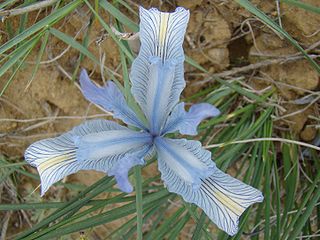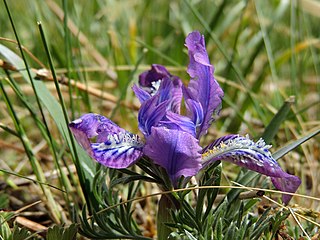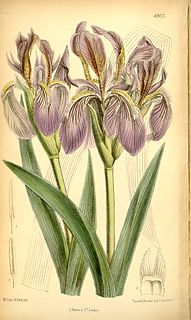
Iris japonica is a native of China and Japan. It is a species in the genus Iris, in the subgenus Limniris and within the Lophiris section. It is a rhizomatous perennial plant, with pale blue, lavender or white flowers with an orange or yellow crest. It is cultivated as an ornamental plant in temperate regions.

Iris milesii is a plant species in the genus Iris, subgenus Limniris and in the section Lophiris. It is a rhizomatous, beardless perennial plant, native to the Himalayas, India and China. It has pinkish-violet, or pinkish purple, or pinkish-lavender or pinkish lilac flowers, with a fringed yellow or orange crest. It is cultivated as an ornamental plant in temperate regions.

Iris minutoaurea is a beardless iris in the genus Iris, in the subgenus Limniris and in the series Chinenses of the genus. It is a rhizomatous herbaceous perennial of eastern Asia, native to China and Korea. It has been naturalized in Japan. It has long grassy-like leaves, short stem and bright yellow or pale yellow flowers. It is cultivated as an ornamental plant in temperate regions.
Iris proantha is a beardless iris in the genus Iris, in the subgenus Limniris and in the series Chinenses of the genus. It is a rhizomatous herbaceous perennial.
Iris kobayashii is a beardless iris in the genus Iris, in the subgenus Limniris and in the series Tenuifoliae of the genus. It is a rhizomatous herbaceous perennial, from China. It has slightly twisted leaves, short stems and 1 to 2 purple or blue and yellow flowers.
Iris loczyi is a beardless iris in the genus Iris, in the subgenus Limniris and in the series Tenuifoliae of the genus. It is a rhizomatous herbaceous perennial, from a wide area of Asia, including Afghanistan, Iran, Kazakhstan, Tajikistan, Mongolia, Tibet and China. It has long thin grey green leaves, long stems and 1 flower in pale violet, blue violet, lavender or light blue.

Iris tenuifolia is a beardless iris in the genus Iris, in the subgenus Limniris and in the series Tenuifoliae of the genus. It is a rhizomatous herbaceous perennial, from a wide region over central Asia, including Afghanistan, Pakistan, ; Kazakhstan, Uzbekistan and Mongolia and in China. It has long greyish-green leaves, short stem and pale violet, lilac, pale blue, or purple flowers.

Iris halophila is a species in the genus Iris, it is also in the subgenus Limniris and in series Spuriae. It is a rhizomatous perennial plant, with yellow, white or violet flowers. It is cultivated as an ornamental plant in temperate regions. It comes from a wide range from eastern Europe to China in Asia. It was known for a long while as a subspecies of Iris spuria, before being treated as a separate species in its own right.
Iris halophila var. sogdiana is a species in the genus Iris, it is also in the subgenus Limniris and in series Spuriae. It is a variety of Iris halophila. It was once a species in its own right as Iris sogdiana, before being re-classified as a synonym of Iris halophila, but it has been re-classed again as a variant of Iris halophila. It is a rhizomatous perennial plant, with blue-violet flowers. It is cultivated as an ornamental plant in temperate regions.
Iris latistyla is a plant species in the genus Iris, it is also in the subgenus Limniris and in the section 'Lophiris section, although it was thought to be listed within Iris subg. Nepalensis in some sources. It is a rhizomatous perennial, from Tibet and China, with violet or blue-purple flowers. It is cultivated as an ornamental plant in temperate regions.
Iris bloudowii is a species in the genus Iris, it is also in the subgenus of Iris and in the Psammiris section. It is a rhizomatous perennial, from Russia, Siberia, Kazakhstan, Mongolia and China, with sickle-shaped leaves, slender stem and 2 bright or pale yellow flowers. It is cultivated as an ornamental plant in temperate regions.
Iris mandshurica is a species in the genus Iris, it is also in the subgenus of Iris and in the Psammiris section. It is a rhizomatous perennial, it is found in Russia, China, and Korea. It has green sword-like leaves, smooth green stem and yellow flowers, with yellow-purple veining and a yellow beard. It is cultivated as an ornamental plant in temperate regions.

Iris potaninii is a species in the genus Iris, it is also in the subgenus of Iris and in the Psammiris section. It is a rhizomatous perennial, from Siberia in Russia, Mongolia and China. It is a dwarf plant, having either subterranean or very small stems, long thin leaves and yellow, or dark violet to purplish blue flowers. It is cultivated as an ornamental plant in temperate regions.
Iris cuniculiformis is a plant species in the genus Iris, it is also in the subgenus Iris and in the section Pseudoregelia. It is a rhizomatous perennial, from China, it has long and thin green leaves, and 1 lilac large flowers, that have yellow or grey beards. It is cultivated as an ornamental plant in temperate regions.
Iris goniocarpa is a plant species in the genus Iris, it is also in the subgenus of Iris and in the section Pseudoregelia. It is a rhizomatous perennial, from China, India, Burma and Bhutan. It has yellow green to dark green, long leaves, slender stem and, one flower between blue, lavender-blue, lilac, blue-violet or blue-purple. It is cultivated as an ornamental plant in temperate regions.
Iris leptophylla is a plant species in the genus Iris, it is also in the subgenus Iris and in the section Pseudoregelia. It is a rhizomatous perennial, from China. It has thin, long grey-green leaves, long slender stem and 2 fragrant purple, blue-purple, violet or lavender pink flowers. It is cultivated as an ornamental plant in temperate regions.
Iris narcissiflora is a plant species in the genus Iris, it is also in the subgenus Iris and in the section Pseudoregelia. It is a rhizomatous perennial, from China. It has pale green, thin, sword-shaped leaves, medium-long slender stem and 1 yellow flower. It is cultivated as an ornamental plant in temperate regions.
Iris psammocola is a plant species in the genus Iris, it is also in the subgenus Iris and in the section Pseudoregelia. It is a rhizomatous perennial, from China. It has grass-like leaves, short stems, yellow flowers. It is cultivated as an ornamental plant in temperate regions.

Iris tigridia is a plant species in the genus Iris, it is also in the subgenus Iris and in the section Pseudoregelia. It is a rhizomatous perennial, from Kazakhstan, Russia, Mongolia and China. It has dark green or greyish green, grass-like leaves, a short slender stem and a single flowers that are either violet, dark blue, blue-purple, dark purple, mauve, lilac, lavender, or light purple. It is cultivated as an ornamental plant in temperate regions.

Iris scariosa is a plant species in the genus Iris, it is also in the subgenus Iris. It is a rhizomatous perennial, from the mountainsides of Russia, Kazakhstan, Mongolia and China. It has sword-like, or sickle shaped, blue green or grey-green leaves, a short flowering stem, 3 or 4 membranous or semi-transparent flower bud leaves, 2 violet, reddish violet, lilac, blue-purple, or blue flowers in late spring, with yellow or white beards. It is cultivated as an ornamental plant in temperate regions. It was merged with another similar iris in the region, and Iris glaucescens became a synonym of Iris scariosa, before being divided into two separate species again. Although some sources still call it the main species, despite a slight colour difference.







